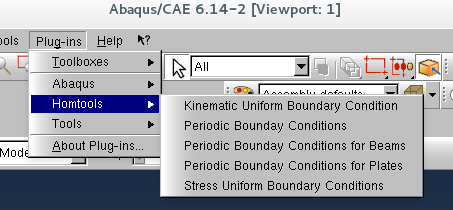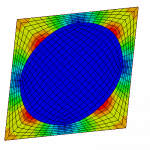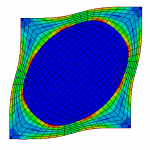Heterogeneous Materials

Localisation boundary conditions
The following figures illustrate a simple 2D test case of a stiff elastic cylindrical filler in a soft elastic matrix, treated with the three available methods in Homtools: KUBC (Kinematic Uniform Boundary Conditions), PBC (Periodic Boundary Conditions), SUBC (Static Uniform Boundary Conditions).These methods require specific boundary conditions.
This method consists in applying on the boundary the displacement field that would occur if the strain were uniform inside the RVE.
|
In small strains, the boundary conditions are :
in which :
|
In finite strains, the boundary conditions are :
in which :
|
|
In small strains, the boundary conditions are :
in which :
|
In finite strains, the boundary conditions are :
in which :
|
|
In small strains, the boundary conditions are :
A quantity is said to be "periodic" (resp. "antiperiodic") when it takes the same value (resp. opposite value) at two opposite points on the boundary (one of them being the image of the other by translation of a periodicity vector). |
In finite strains, the boundary conditions are :
|
There is no restriction concerning the use of this method (periodic holes and rigid parts intersecting the boundary are permitted but a specific treatment is required for the rigid parts).
In Homtools, we use Reference Points to prescribe the average loading and these constraints.
Reference Points to apply the average loading and the specific boundary conditions
The average strains are introduced as degrees of freedom of Reference Points and Homtools automatically generates the linear constraints (*equation) between these additionnal degrees of freedom and the displacements on the boundary of the RVE. Thanks to duality properties, the reaction forces at the Reference Points are the average stresses multiplied by the volume of the RVE. With this method, prescribing average strains or stresses becomes as easy as prescribing displacements or concentrated forces at a node. Furthermore, obtaining the relationship between the average strain and the average stress does not require any specific post-treatment.
For fiinte strain problems, the degrees of freedom of the Reference Points are the components of the average deformation gradient tensor and the reaction forces are the components of the avrage Piola-Kirchoff II stress tensor.
How to use Homtools
The main steps are :
![]() mesh the RVE
mesh the RVE
![]() in the "Interaction" module, create the Reference Points (2 for 2D problems in plane stress or strain or 3D problems in small strains, 3 for 3D problems in finite strains)
in the "Interaction" module, create the Reference Points (2 for 2D problems in plane stress or strain or 3D problems in small strains, 3 for 3D problems in finite strains)
![]() in the "Interaction" module, choose "Homtools" in the drop off menu "Plug-in" and answer the questions.
in the "Interaction" module, choose "Homtools" in the drop off menu "Plug-in" and answer the questions.

![]() in the "Load" module, prescribe the average strains components or/and the stresses components by prescribing the degrees of freedom (dsplacements) or the nodal forces at the reference points.
in the "Load" module, prescribe the average strains components or/and the stresses components by prescribing the degrees of freedom (dsplacements) or the nodal forces at the reference points.
![]() after solving the problem, in the "Vizualisation" module, you can obtain the effective response of the RVE by the postreatment of the displacements and yhe nodal forces at the Reference Points.
after solving the problem, in the "Vizualisation" module, you can obtain the effective response of the RVE by the postreatment of the displacements and yhe nodal forces at the Reference Points.
Check the following video to see the steps required to define a complete homogenization problem (in french).






